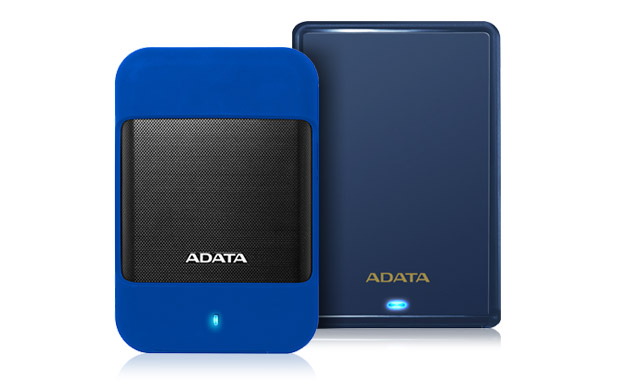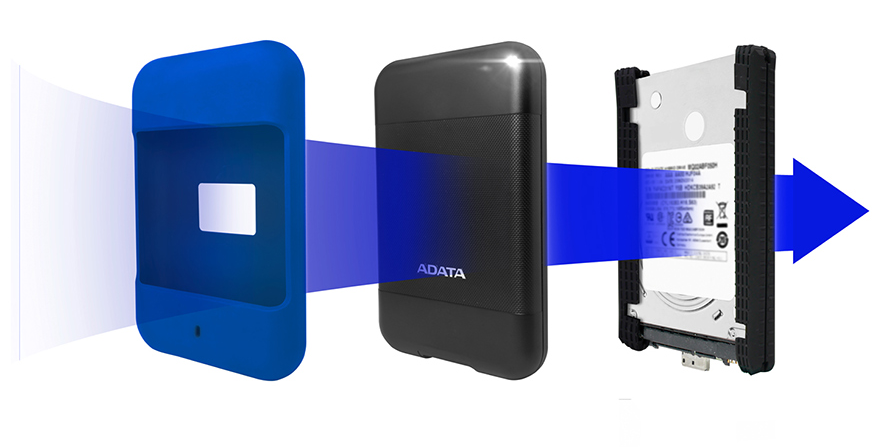Adata Announces Rugged HD700, Slimmer HV602S External HDDs
Adata announced its new HD700 and HV620S hard drives. The HD700 is a ruggedized drive that the company designed to weather the shocks and vibrations found in the mobile world, and the HV620S slots in as the slim and stylish drive.
HD700 Gets Rugged
The HD700 is the more interesting drive of the two due to its ruggedized design, which can tolerate a wide range of hostile conditions, such as water, dust, variable temperatures and shock conditions. The drive conforms to the MIL-STD-810G 516.6 requirements, which is a military specification that manufacturers can only achieve if their products pass an extensive range of shock-based tests.
The HD700 employs a triple-layer design to handle the extremes that includes an inner cushioned mounting, a shock resistant plastic enclosure, and a removable silicone/rubber layer (multiple colors available). A G Shock Sensor alerts the user via a blinking red light when the device is under duress due to a shock-related event, and it parks the drive heads to prevent data destruction. The light returns to blue when the drive resumes normal operation.
The HD700 is certified as waterproof and dustproof through the IEC IP56 specification, which assures that it will sustain a range of water-based incidents, such as dripping, spraying, splashing and jetting water, and of course, full immersion. The drive also adds in 256-bit AES data encryption, so the James Bond types can use it as well. The drive comes in both 1 TB and 2 TB models and communicates via USB 3.0.
Slimmer, More Stylish: HV620S
The HV620S is the slim and non-rugged drive for more mundane use cases. The new model slots in as the thinner variant of the HV620 and features a slim 11.5 mm Z-height (thickness). The drive features the same G Shock sensor protection as the HD700, although it's not military-grade shock resistant, and it also employs AES-256 encryption.
The HV620S comes in 1 TB capacities only and communicates via USB 3.0. Adata has not released the MSRP or performance specifications of either device, but we expect the fair to middling sequential throughput seen with most external hard drives.
Shock(ing)
It's no secret that SSDs are supplanting HDDs in the notebook market (44 percent of units shipped last year), and the SSD vendors are now aiming directly at the external and portable HDD segment with offerings like the Samsung Portable SSD T3 and the SanDisk Extreme 500 Portable SSD. These new flashy competitors are nearly impervious to shock, which is one of the key reasons that they are experiencing rapid adoption. The HD700 levels the playing field a bit in this respect, as military-grade shock resistance is sufficient for most users.
Get Tom's Hardware's best news and in-depth reviews, straight to your inbox.
HDDs still offer a tremendous cost advantage, and that equates to additional capacity per dollar. For instance, the Samsung T3 weighs in at roughly $750 for 2 TB, and the SanDisk Extreme 500 commands $150 for its maximum 480 GB capacity point. By contrast, external hard drives that are similar to the Adata drives tend to fall into the $80 range for 1 TB and $125 range for 2 TB capacity points.
The race might get a bit closer as the price of flash drops. Professional users and the speed-obsessed will go for flash, while most mainstream users will still opt for cheap HDD capacity.
Paul Alcorn is a Contributing Editor for Tom's Hardware, covering Storage. Follow him on Twitter and Google+.

Paul Alcorn is the Editor-in-Chief for Tom's Hardware US. He also writes news and reviews on CPUs, storage, and enterprise hardware.


